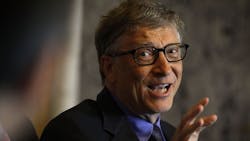During a press conference on the opening day of the 2015 United Nations Climate Change Conference in Paris, Bill Gates, still generally recognized as the richest individual in the world, described his new initiative, Breakthrough Energy Coalition, through which a group of mega-rich philanthropists has pledged $2 billion for clean energy. Gates, who reportedly has a net worth of more than $84 billion, said he will contribute around $1 billion, adding, “Hopefully, I’ll see a few things that are so exciting that I’ll want to go beyond that.” He is being joined in this effort by 26 private investors, including Africa’s richest man, Nigerian businessman Aliko Dangote; Alibaba Group Holding Ltd. chairman and founder Jack Ma; Hewlett Packard CEO Meg Whitman; Soros Fund Management Chairman George Soros; Facebook CEO Mark Zuckerberg and his wife, Dr. Priscilla Chan; Virgin Group founder Richard Branson; Amazon.com CEO Jeff Bezos; and the University of California.
The premise of the initiative is that many (perhaps most) businesses won’t spend their owners’/shareholders’ money to adopt clean-energy strategies at a cost premium. So, the coalition’s strategy is simple: help close the gap between the cost of conventional high-carbon energy sources (fossil fuels) and low-carbon alternatives, some of which may not yet have been discovered. As one would guess from the investor list—for the most part, capitalists—they’re not talking about handouts; the goal is to invest in new clean-energy technologies that will make money. Also, they are committed to encouraging governments to allocate more money for clean-energy-technology research and development. Their message is clear and simple: Invest early and in a broad range of sectors.
In developed countries, HVACR is a—perhaps the—major energy consumer in commercial buildings, and, with that in mind, our industry has worked hard to make its products more efficient. Perhaps Gates and company should consider investing in research and development to improve the efficiency of systems and equipment that use energy, rather than just systems and equipment that produce it. The outcomes may not be as dramatic, but they certainly will be quicker.
Here at home, we scored a victory on the energy-conservation front last week, as the U.S. House of Representatives, by a vote of 249-174, passed the North American Energy Security and Infrastructure Act of 2015 (H.R. 8), the first comprehensive energy bill to make it out of the House in eight years. The bill strengthens the Department of Energy’s role as a technical advisor in the energy-codes process and requires that any new proposals show a 10-years-or-less simple payback period. Now, we await action by the Senate.
About the Author
Larry Clark
A member of HPAC Engineering’s Editorial Advisory Board, Lawrence (Larry) Clark, QCxP, GGP, LEED AP+, is principal of Sustainable Performance Solutions LLC, a South Florida-based engineering firm focused on energy and sustainability consulting. He has more than two dozen published articles on HVAC- and energy-related topics to his credit and frequently lectures on green-building best practices, central-energy-plant optimization, and demand-controlled ventilation.

